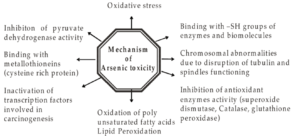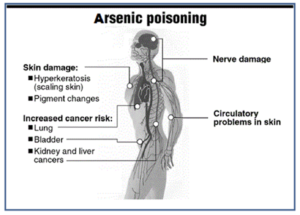Arsenic
- Arsenic (Atomic No- 33) is a steel gray, brittle, crystalline metalloid belonging to group V-A of the periodic table. It tarnishes in air and when heated is rapidly oxidized to aresnous oxide (As2O3) with odor of garlic.
- Arsenic is found in soil, water and air as common environmental toxicant. The average daily human intake of arsenic is about 10 μg, largely ingested with food and water. The major source of occupational exposure to arsenic-containing compounds is from the manufacture of arsenical herbicides and pesticides, most computer chips using silicon-based technology, compound (types III–V) semiconductors that are used for making light-emitting diodes (LEDs), as well as laser and solar devices.
Chemistry and mechanism of action

Figure: Possible Mechanism of Action of Arsenic Toxicity
The exact mechanism of the action of arsenic is not known. Arsenic may cause cell injury and death by multiple mechanism.
At a biochemical level, inorganic arsenic in the pentavalent state may replace phosphate in several reactions. In the trivalent state, inorganic and organic (methylated) arsenic may react with critical thiols in proteins and inhibit their activity. Especially the pyruvate dehydrogenase system is sensitive to trivalent arsenicals because of their interaction with two -SH groups of lipoic acid to form a stable 6-membered ring. Regarding cancer, potential mechanisms include genotoxicity, altered DNA methylation, oxidative stress, altered cell proliferation, co-carcinogenesis, and tumor promotion.
Arsenic Poisoning
Arsenic poisoning is usually homicidal but may occasionally occur accidentally. Ground water in some areas of the world contains high concentration of arsenic and cause chronic poisoning. Initially, it enters the human body through ingestion, inhalation, or skin absorption. After entering the body, it is distributed in a large number of organs, including the lungs, liver, kidney, and skin. It is very difficult to diagnose early symptoms of arsenicosis because such nonspecific symptoms may also be present in many other diseases.

Figure- Symptoms of arsenic poisoning
Acute arsenic poisoning
Within an hour of arsenic intake, GI disturbance is experienced. Sometimes, it may be delayed up to 12 hours. Burning lips, difficulty in swallowing, constriction of throat is seen in beginning followed by gastric pain, projectile vomiting and severe diarrhea. Hypotension, fluid and electrolyte disturbances, mental status changes, electrocardiographic abnormalities, respiratory failure can result. In severe poisoning, death may occur within 24 hours. Quantitative measurement of 24-hour urinary arsenic excretion is the only reliable laboratory test to confirm arsenic poisoning.
Treatment includes gastric emesis or lavage, chelation therapy, electrolyte and fluid replacement, and cardiorespiratory support. Dimercaprol is the popular antidote used.
Chronic Arsenic Poisoning
There is a strong relationship between chronic ingestion of Arsenic and deleterious human health effects. Exposure to Arsenics leads to an accumulation of Arsenic in tissues such as skin, hair and nails, resulting in various clinical symptoms. The most common early signs of chronic arsenic poisoning are muscle weakness and aching, skin pigmentation (especially of the neck, eyelids, nipples, and axillae), hyperkeratosis, and edema. GI involvement is less prominent in long-term exposures. The breath has a garlic odor.
Late manifestations of arsenic poisoning include jaundice, aplastic anemia and peripheral neuropathy. Neurological effects of Arsenic may develop within a few hours after ingestion, but usually are seen in 2—8 weeks after exposure. Symptoms like paresthesia’s, numbness and pain, particularly in the soles of the feet are seen. Electrophysiological studies performed on patients with Arsenic neuropathy have revealed a reduced nerve conduction velocity, typical of those seen in axonal degeneration.
There is also an increased risk of skin, internal organ, and lung cancers. Cardiovascular disease and neuropathy have also been linked to Arsenic consumption. Verbal IQ and long-term memory can also be affected and can suppress hormone regulation and hormone mediated gene transcription. Increases in fetal loss and premature delivery, and decreased birth weights of infants, can occur even at low (<10 μg/L) exposure levels. Malnourished people have been shown to be more predisposed to As-related skin lesions. There may be loss of hair; finger nails become brittle and may eventually drop off.
Chemical analysis of hair and bones are the major part of the diagnosis. Treatment of chronic arsenic poisoning consists of prolonged administration of dimercaprol and penicillamine. The duration of therapy is determined by the clinical condition of the patient, and the decision is aided by periodic determinations of urinary arsenic concentrations. Dialysis may become necessary with severe arsenic-induced nephropathy; successful removal of arsenic by dialysis has been reported.

Figure- Skin lesions due to arsenic poisoning
Prevention
The use of arsenic contaminated drinking water should be stopped. Well water, particularly in areas near mining activity, should be tested for metals. Safe drinking water and well-nourished food is essential for prevention of chronic arsenic toxicity. The diet with low protein, fats, vitamins and minerals may increase the risk of arsenic-induced skin lesions and other malignant disease. Good nutrition and safe drinking water can remediate the melanosis and decrease the keratosis. Various reports suggested that population with good nutrition is less susceptible to arsenical disease.
References
- Adriano, D.C., A.L. Page, A.A. Elseewi, A.C. Chang, and I. Straughan. 1980. J Environ Qual 9: 333 – 344.
- Ainsworth, C.C., and D. Rai. 1987. Chemical Characterization of Fossil Fuel Combustion Wastes. EPRI Rep EA-5321. Electric Power Res Inst, Palo Alto, CA. Akins, M.B., and R.J. Lewis. 1976. Soil Sci Soc Am J. 40: 655 – 658.
- Astolfi, E., A. Maccagno et al. 1981. Biol Trace Elem Res 3: 133 – 143.
- Michael F. Hughes. Arsenic toxicity and potential mechanisms of action. Toxicology letters. 133(1):1-16.
- Schoolmeester WL, White DR. Arsenic Poisoning. Southern Medical Journal. 73(2):198-208.
- C. Saha , A. K. Dikshit , M. Bandyopadhyay & K. C. Saha. A Review of Arsenic Poisoning and its Effects on Human Health. 29(3): 281-313.
- Campbell JP, Alvarez JA. Acute arsenic intoxication. American Family Physician, 30 Nov 1989, 40(6):93-97
- Simon Kapaj, Hand Peterson, Karsten Liber, Prosun Bhattarcharya. Human Health Effects from Chronic Arsenic Poisoning–A Review. Journal of Environmental Science and Health. 41(10):2399-2428.
- Alfred Franzblau M.D. & Ruth Lilis M.D. Acute Arsenic Intoxication from Environmental Arsenic Exposure. Archives of Environmental Health: An International Journal. 44(6):385-390.
- Nrashant Singh, Deepak Kumar and Anand P. Sahu. Arsenic in the environment: Effects on human health and possible prevention. Journal of Environmental Biology. April 2007, 28(2) 359-365.
- Vahidnia, G.B. van der Voet, F.A. de Wolff. Arsenic neurotoxicity — A review. First Published October 1, 2007 Review Article Human and experimental toxicology.
- Pharmacology and Pharmacotherapeutics book, R.S. Satoskar. Page no- 1095-1097.
- Goodman and GILLMAN’S Manual of Pharmacology and Therapeutics. Page no- 1137-1139.